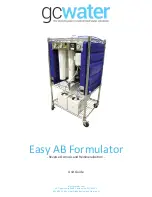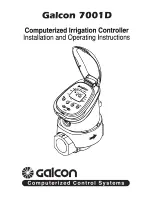
56
Culligan® Series M2 Reverse Osmosis
56
Cat. No. 01023095
10. Once all the desired flows are set, allow the system to run for approximately 30 minutes, and then record the
following measurements using the units gauges (U), GROC information screens (G), and your instruments (I):
a. Feed Flow Rate, gpm (G)
b. Feed Water Temperature, °F (I)
c. Feed Water SDI (I)
d. Feed TDS, ppm (I)
e. Inlet Pressure, psig (U)
f. System (pump outlet) pressure, psig (U)
g. Product TDS, ppm (G)
h. Product Flow, gpm (G)
x TCF
1
=
i. Product Temperature, °F (G)
j. Product Pressure, psig (I)
k. Concentrate (waste) flow, gpm (a–h)
l. % Recovery (see
)
1
TCF = Temperature Correction Factor. Refer to
for this value.
NOTICE
The Global RO Controller has a feature which records historical data. The intial startup data is kept
in the controllers memory. It is still a good idea to record the values on a separate sheet of paper
and keep the data near the unit in case of electrical problems.
11. Turn the power switch OFF. Connect the product tubing to the service plumbing.
12. Test the operation of the pressure switch by closing the inlet water supply valve. The unit should shut off imme-
diately, and the Low Pressure light should turn on.
CAUTION! If the unit does not shut off, turn the unit OFF immediately to prevent pump damage.
Disconnect electrical power source, then check the wiring and replace the switch, if
necessary.
13. Open the inlet water supply valve. The unit should restart and the light should go out.
14. If connected, test the storage tank level control shutdown and the pretreatment lockout function.
Normal Operation
During normal operation, the system usually will start up and shut down based on signals from a level control or pressure
switch. Adjust the feed pressure as required (no higher than 150 psig) to maintain a constant product flow. Record the
performance data regularly and compare it to the performance on initial start up. If any changes are noticed, the product
flow should be normalized to determine if cleaning is required (see Product Flow Calculations on the next page).
















































